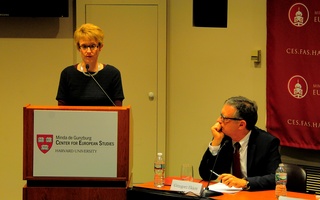Much of the world's attention was focused on Ukraine in late April and early May, following the meltdown at the Chernobyl nuclear power plant. It was the latest in the republic's history of catastrophies, which include a devastating famine in 1933 and repeated foreign conquests.
Ukraine is traditionally referred to as the Soviet Union's "Breadbasket," known for its extremely fertile "black earth" and wheat production. It also has huge quantities of coal and iron, as well as large reserves of oil, natural gas and various minerals.
Its population numbers approximately 50 million people, of which 2.3 million live in the capital, Kiev. Ukraine is bordered on the south by the Black Sea; on the west and southwest by Poland, Czechoslovakia, Hungary and Romania; and on the north and northeast by Byelorussia and Russia. It covers more than 230,000 square miles.
Ukrainians are renowned for being fiercely nationalistic. During the past three centuries, the Russian empire, Soviet Union, Nazi Germany, Poland, Romania and Czechoslovakia have ruled all or part of Ukraine with an iron fist. In 1933, a famine, killing an estimated seven million Ukrainian villagers, took place under Stalin's control.
The United States numbers approximately 1 million Ukrainian immigrants, with the heaviest concentration in New York City, Buffalo, Rochester, Philadelphia and Chicago. Canada's Ukrainian community, which is about the same size as the United States', wields much greater power in that nation of under 30 million people.
Read more in News
Carter Lord, Harvard's Star End, Will Sign With Cowboys of NFLRecommended Articles
-
Finding Their Roots In Ukrainian StudiesWhile growing up in Long Island City, Walter Hanchuk was constantly reminded of his Ukrainian heritage. His parents often spoke
-
Ukraine's Botched ElectionThe run-off election for president in Ukraine is beginning to disintegrate into a madness that makes the post-2000 election battle
-
Prof Looks Beyond Traditional HistoryAfter penning a biography on the greatest Ukrainian historian of the 20th century, Serhii Plokhii is now prepared to take
-
 Scholars Discuss Origins of Ukraine Crisis, Int'l Reaction
Scholars Discuss Origins of Ukraine Crisis, Int'l Reaction -
Fellows Use Postcards to Humanize Victims of Ukrainian ConflictTheir project, which sends postcards to individuals around the world containing idyllic photos of Donetsk, Ukraine juxtaposed with death notices, has sought to raise awareness of lost lives in Ukraine.












